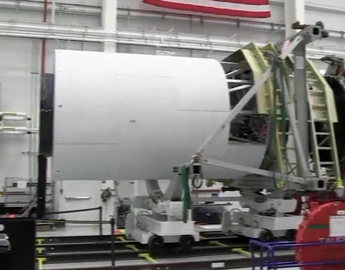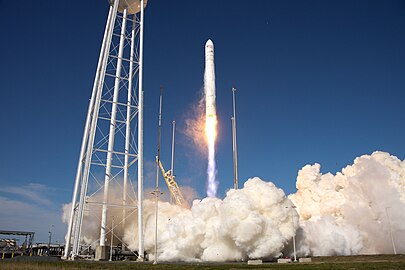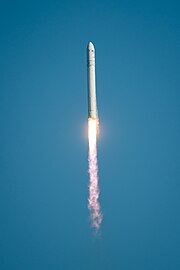Antares A-ONE mission was the maiden flight of Orbital Sciences Corporation' Antares launch vehicle including the ascent to space and accurate delivery of a simulated payload, the Cygnus Mass Simulator (CMS), which was launched 21 April 2013.[5] It was launched from Pad 0A at the Mid-Atlantic Regional Spaceport (MARS), Wallops Flight Facility, Virginia.[5] The simulated payload simulates the mass of the Cygnus cargo spacecraft.[5] This dummy payload was sent into an orbit of 240 km × 260 km (150 mi × 160 mi) with an orbital inclination of 51.6°, the same launch profile it uses for Orbital's Cygnus cargo supply missions to the International Space Station (ISS) for NASA.[5]
 The Antares 110 lifts off at the start of the mission | |
| Names | Simulated Cygnus Payload [1] |
|---|---|
| Mission type | Test flight |
| Operator | Orbital Sciences Corporation |
| COSPAR ID | 2013-016D |
| SATCAT no. | 39145 |
| Website | https://news.northropgrumman.com/ |
| Mission duration | 19 days |
| Spacecraft properties | |
| Spacecraft | Cygnus mass simulator |
| Manufacturer | Orbital Sciences Corporation |
| Launch mass | 3,800 kg (8,400 lb) |
| Dimensions | 5.061 m × 2.896 m (16.60 ft × 9.50 ft) |
| Start of mission | |
| Launch date | 21 April 2013, 21:00:00 UTC[2][3] |
| Rocket | Antares 110[4] |
| Launch site | Wallops Pad 0A |
| Contractor | Orbital Sciences Corporation |
| End of mission | |
| Disposal | Deorbited |
| Decay date | 10 May 2013 |
| Orbital parameters | |
| Reference system | Geocentric orbit[5] |
| Regime | Low Earth orbit |
| Perigee altitude | 240 km (150 mi) |
| Apogee altitude | 260 km (160 mi) |
| Inclination | 51.6° |
 Orbital Sciences insignia | |
This launch along with several other activities leading up to it, are paid milestones under NASA's Commercial Orbital Transportation Services (COTS) program.[6]
Primary payload
The primary payload was the Cygnus Mass Simulator. It had a height of 5.061 m (16.60 ft), a diameter of 2.896 m (9 ft 6.0 in) and a mass of 3,800 kg (8,400 lb).[7] It was equipped with 22 accelerometers, 2 microphones, 12 digital thermometers, 24 thermocouples and 12 strain gages.[7]
Secondary payloads
Four Spaceflight Industries Inc. CubeSat nanosatellites were deployed from the dummy payload.[8]
The secondary payloads were four CubeSats that were deployed from the CMS.[7] Three of them were PhoneSats, 1U CubeSats built by NASA's Ames Research Center.[7] These were named Alexander, Graham and Bell, after the Alexander Graham Bell, inventor of the telephone.[7] The purpose of these three satellites was to demonstrate the use of smartphones as avionics in CubeSats.[7] They each had a mass of 1,124 kg (2,478 lb) and were powered by lithium batteries.[7] The fourth nanosat was a 3U CubeSat, called Dove-1, built by Cosmogia Inc. It carried a "technology development Earth imagery experiment" using the Earth's magnetic field for attitude control.[7][9]
Mission timeline
- Lift off of the Antares launch vehicle occurs two seconds after the first stage engines are ignited
- The first stage engines shut off 228 seconds after lift-off
- At 233 seconds, the first stage separates from the second
- At 317 seconds, the payload fairing is jettisoned
- At 326 seconds, the second stage's engine is ignited
- At 481 seconds, the second stage is shut off
- At 601 seconds, the Cygnus Mass Simulator separates [5]
| Attempt | Planned | Result | Turnaround | Reason | Decision point | Weather go (%) | Notes |
|---|---|---|---|---|---|---|---|
| 1 | 17 Apr 2013, 5:00:00 pm | scrubbed | — | technical | 17 Apr 2013, 4:44 pm (T-12:00 hold) | 60% [10] | Premature disconnect of upper stage umbilical cable during T-12:00 hold [11] |
| 2 | 20 Apr 2013, 6:10:00 pm | scrubbed | 3 days, 1 hour, 10 minutes | weather | 20 Apr 2013, 4:30 pm | 90% | [12] |
| 3 | 21 Apr 2013, 5:00:00 pm | success | 0 days, 22 hours, 50 minutes | 80% | First flight of Antares [13] |
Gallery
See also
References
External links

- Antares Pre-Launch "A-ONE Mission" Briefing
- Antares A-One Mission Overview
- NASA WFF mission page
- Video of Pre-Flight Press Conference - Part 1 - YouTube (NASA TV)
- Video of Pre-Flight Press Conference - Part 2 - YouTube (NASA TV)
- Video of Antares A-One being rolled out to launch pad - YouTube (NASA TV)
- Video of the launch of the Antares A-One Mission - YouTube (NASA TV)



